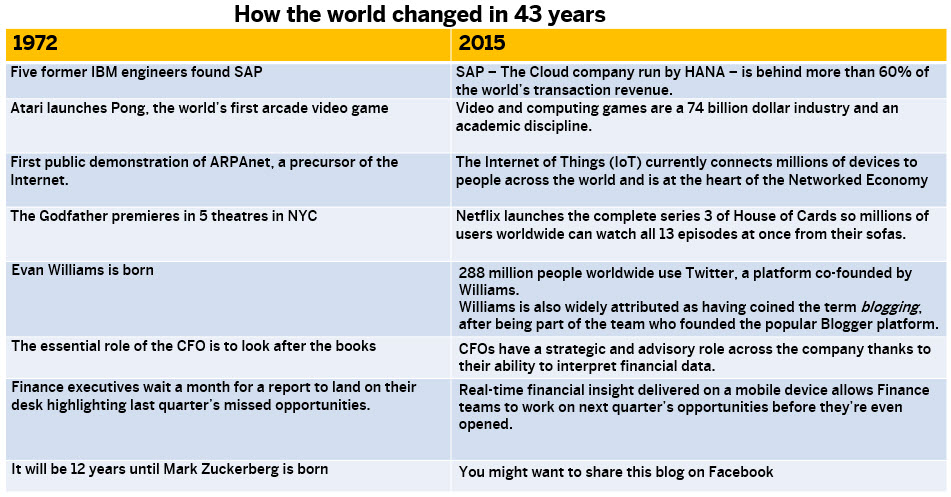
- SAP Community
- Products and Technology
- Additional Blogs by SAP
- Welcome to the Perfect Enterprise
- Subscribe to RSS Feed
- Mark as New
- Mark as Read
- Bookmark
- Subscribe
- Printer Friendly Page
- Report Inappropriate Content
What would you do if you completely reimagined your company as a real time enterprise? Leaving you free to define new business models, design new business processes –and to deliver like never before?
What if all your business applications – on premise or in the Cloud – could seamlessly talk to each other in real time, with consumer grade user interfaces?
Now imagine your enterprise opened to the outside world and network of your suppliers, customers and future workforce.
That vision is closer than you think.

In 1972, the crew of the Apollo 17 took the iconic Blue Marble photograph of the Earth. Perhaps because it was the last picture of our planet taken by human hands (Apollo 17 was the last manned Moon mission) it has become one of the most distributed images in history.
If we took a snapshot of what running a business looked like in 1972, what would see? Probably the words that come to mind are hierarchical, static, complex, manual, rigid, slow. Decision making was most likely based on retrospective knowledge and established rules.
From Mainframe to Desktop to the Device
Over 40 years later, the world has come a long way – from the mainframe in the basement to the device in your pocket. Technology has transformed business – and business has transformed technology, allowing us to conduct business in ever smarter ways.
In the world of Enterprise software, the evolution of these 40 years has been substantial. From earlier MRP to ERP systems, via the short-lived “best of breed” players, back once again to the proven benefits of integrated business suites. Today enterprises are able to move parts of their operations to the Cloud, execution to the device, and business process outside of the enterprise.
The need for integration, consistency and coherency is once again a top concern that only the suite players can truly address. So how do you get the various areas of the business talking to each other? And what is the journey to take?
Your journey to the Perfect Enterprise
To remain competitive, modern business suites need to fit into a world that comprises Cloud(s), Internet of Things, Big Data, Mobility, Social Media, OmniChannel commerce – the list goes on. Enterprises need to run in real time, users expect intuitive interfaces on any device, and everyone expects to make decisions based on real-time insight from integrated data from a variety of sources – from within and beyond the enterprise.
Some companies have nailed it. I’ve recently witnessed the adoption of real-time inventory management by a manufacturer of machine components. Their entire ecosystem - that’s dealers, customers, employees – have real-time access to the same stock data. The move has delivered dramatic increase in inventory turnover, and cut down returns.
They have achieved what we at SAP like to call The Perfect Enterprise: by breaking the limitations of the past and using real time and network capabilities, they transformed their business.
Run Simple
Sounds great on paper, but years of ingrained complexity need to be ironed out to make way for the Perfect Enterprise. At SAP, we invite you to take on the challenge of Run Simple. What’s holding you back? How can you leverage technology to enable new business processes and models?
The role of technology is as the enabler of innovation. It is not technology for the sake of it. In the same way you just want your phone to deliver useful, beautiful functionality – regardless of the technology behind it - what we passionately care about at SAP is to provide business value. Because at the heart of Run Simple is real business value. Tweet this
Platform, Applications, Network
This is not science fiction. Taking advantage of the power of an open and collaborative platform, connected business networks, and use of Industry & Line of Business specific applications, all industries are beginning this transformation towards the Perfect Enterprise:
- Automotive companies selling mobility instead of cars
- Predictive Analytics in utilities outage management or supply chain optimization
- From mass production to personalized offers
- Everything as a Service

Re-imagine – Design – Deliver.
40 years after the original Blue Marble, in 2012 NASA used satellites to create the Black Marble map: a view of the Earth at night. According to NASA, ‘it took satellites 312 orbits and 2.5 terabytes of data to get a clear shot of every parcel of Earth’s land surface and islands’.
The patterns of night lights in our planet have provided several business uses. Social scientists look at the night lights to model geographical distribution of economic activity. City planners use night time images to monitor blackouts.
NASA made use of technology to look at a 4.5 billion year old planet from a new angle. Here’s your opportunity to be equally bold.
Think of how you could completely reinvent the core of your business and do things you never thought possible. With the power of SAP’s platform, applications and network, you too can trace your journey to the Perfect Enterprise.

Find out more:
Simon Paris is president of Industry Cloud at SAP
Follow Simon on Twitter: @SimonMParis
pictures:
1. NASA Johnson Space Center Gateway to Astronaut Photography of Earth
2. Google Earth
- SAP Managed Tags:
- Digital Technologies
- OS compatibility in Technology Q&A
- SAP Named a Leader in the 2024 Gartner Magic Quadrant for Transportation Management Systems in Supply Chain Management Blogs by SAP
- Cannot generate a PDF after latest Microsoft Office update in Human Capital Management Q&A
- Consuming SAP with SAP Build Apps - Mobile Apps for iOS and Android in Technology Blogs by SAP
- Support for API Business Hub Enterprise in Actions Project in Technology Blogs by SAP